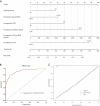Factors Associated with Acute Pulmonary Embolism in Patients with Hypoxia After off-Pump Coronary Artery Bypass Grafting: A Case-Control Study
- PMID: 38343756
- PMCID: PMC10859096
- DOI: 10.2147/JMDH.S447534
Factors Associated with Acute Pulmonary Embolism in Patients with Hypoxia After off-Pump Coronary Artery Bypass Grafting: A Case-Control Study
Abstract
Purpose: This study aims to explore the factors linked to the occurrence of acute pulmonary thromboembolism (PE) within a cohort of patients exhibiting hypoxic saturation (oxygen saturation levels falling below 93%), subsequent to undergoing off-pump coronary artery bypass grafting (OPCABG).
Methods: A retrospective case-control study was conducted. A total of 296 patients met the inclusion and exclusion criteria, divided into PE group (100 cases) and non-PE group (196 cases) according to whether they had PE or not. The preoperative and postoperative information of patients were collected and statistically analyzed.
Results: The results from a multivariate logistic regression analysis indicated the following factors were independently linked to PE following OPCABG: history of smoking (OR = 3.019, 95% CI, 1.437-6.634, P = 0.004), preoperative arterial oxygen partial pressure ≤78.9 mmHg (OR = 3.686, 95% CI, 1.708-8.220, P = 0.001), presence of postoperative lower extremity deep venous thrombosis (OR = 4.125, 95% CI, 1.886-9.310, P < 0.001), elevated postoperative D-dimer levels >6.76 mg/l (OR = 8.078, 95% CI, 3.749-18.217, P<0.001), postoperative NT-BNP levels (OR = 1.001, 95% CI: 1.000-1.001, P = 0.011), and elevated postoperative pulmonary arterial pressure >33.0 mmHg (OR = 10.743, 95% CI: 3.422-37.203, P < 0.001). The developed nomogram exhibited a high predictive accuracy with an area under the curve of 0.913 (95% CI: 0.878-0.948).
Conclusion: When patients have a history of preoperative smoking, decreased preoperative arterial oxygen pressure, postoperative lower limb DVT, increased postoperative pulmonary artery pressure, and elevated postoperative D-Dimer and NT pro-BNP levels, it is recommended to take perioperative preventive measures, timely diagnostic evaluation, and if necessary, anticoagulant treatment. In addition, the results of this study may improve the diagnostic sensitivity of medical staff for postoperative PE in OPCABG, thereby increasing the detection rate and potentially reducing the need for excessive medical imaging procedures.
Keywords: case-control study; off-pump coronary artery bypass grafting; prediction model; pulmonary embolism; risk factor.
© 2024 Yu et al.
Conflict of interest statement
None of the authors have any financial disclosure or conflict of interest to report for this work.
Figures




Similar articles
-
Construction and validation of a risk prediction model for postoperative delirium in patients with off‑pump coronary artery bypass grafting.J Thorac Dis. 2024 Jun 30;16(6):3944-3955. doi: 10.21037/jtd-24-578. Epub 2024 Jun 18. J Thorac Dis. 2024. PMID: 38983165 Free PMC article.
-
Risk factors for acute pulmonary embolism in patients with off-pump coronary artery bypass grafting: implications for nursing.J Int Med Res. 2020 Nov;48(11):300060520971445. doi: 10.1177/0300060520971445. J Int Med Res. 2020. PMID: 33249970 Free PMC article.
-
The Effect of Preoperative and Postoperative Glycemic Control on Acute Kidney Injury After Off-Pump Coronary Artery Bypass Grafting: A Case-Control Study.Heart Surg Forum. 2022 May 31;25(3):E417-E424. doi: 10.1532/hsf.4685. Heart Surg Forum. 2022. PMID: 35787755
-
Interventions for preventing venous thromboembolism in adults undergoing knee arthroscopy.Cochrane Database Syst Rev. 2020 May 6;5(5):CD005259. doi: 10.1002/14651858.CD005259.pub4. Cochrane Database Syst Rev. 2020. Update in: Cochrane Database Syst Rev. 2022 Aug 22;8:CD005259. doi: 10.1002/14651858.CD005259.pub5. PMID: 32374919 Free PMC article. Updated.
-
A critical appraisal of non-invasive diagnosis and exclusion of deep vein thrombosis and pulmonary embolism in outpatients with suspected deep vein thrombosis or pulmonary embolism: how many tests do we need?Int Angiol. 2005 Mar;24(1):27-39. Int Angiol. 2005. PMID: 15876996 Review.
Cited by
-
Decreased Arterial Oxygen Pressure Indicates Hypoxemia, a Well-Known Clinical Sign of Pulmonary Embolism [Letter].J Multidiscip Healthc. 2025 Feb 25;18:1181-1182. doi: 10.2147/JMDH.S523707. eCollection 2025. J Multidiscip Healthc. 2025. PMID: 40026870 Free PMC article. No abstract available.
References
-
- Murashita T. The Current Perspectives on Coronary Artery Bypass Grafting. London: IntechOpen; 2020.
LinkOut - more resources
Full Text Sources
Research Materials
Miscellaneous

